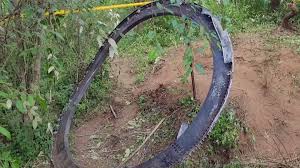
On the afternoon of January 1, 2025, Makueni County was shaken by a rare and alarming event when a large piece of space debris crashed in a residential village. The object, which weighed over 1,000 pounds and had a diameter of 8 feet, was later identified as a separation ring from a rocket. This piece of debris, which had been floating in orbit for an extended period, fell from the sky and landed in a densely populated area at approximately 3 p.m. local time.
Initial Panic and Quick Response
The sudden crash of the massive object sparked immediate panic among the villagers. The sheer size and weight of the debris made it a terrifying sight for the residents, many of whom had never witnessed such an event. Thankfully, no fatalities were reported, although there was concern for the safety of those who might have been in close proximity to the impact zone.

Local authorities, including the police, fire departments, and first responders, were quick to arrive on the scene. Emergency services, including the Kenya Red Cross and St. John Ambulance, also deployed teams to assess the situation and ensure the safety of the community. Fortunately, due to the rapid intervention of the local community and emergency services, there were no major injuries or further risks posed to the residents.
Response from the Kenya Space Agency
The Kenya Space Agency (KSA) was notified of the incident shortly after the debris was located. A specialized team from the agency, along with local law enforcement, quickly secured the area to ensure that no one came into contact with the debris. Preliminary assessments indicated that the object posed no immediate threat to public safety, despite its large size.
A KSA team, comprising experts in space science and engineering, arrived on site to examine the debris and collect it for further analysis. The team cordoned off the area, preventing any unauthorized access, and began the process of securing and transporting the debris to a more controlled environment. Their goal was to determine the exact origin of the object and whether it had any potential link to ongoing space missions or satellite launches.
What is Space Debris?
Space debris refers to non-functional objects or fragments that remain in Earth’s orbit after the completion of space missions. These pieces of debris include spent rocket stages, defunct satellites, and fragments from past collisions or accidental breakups of space vehicles. Space debris is often an ongoing concern for space agencies, as it poses risks to both operational satellites and human space missions.
The piece of space debris that fell in Makueni County was identified as a separation ring from a rocket. Separation rings are components used during the launch phase of rockets to detach the various stages of the vehicle once their fuel is depleted. These components can remain in orbit for years before eventually re-entering the Earth’s atmosphere, sometimes in an uncontrolled manner.
Ongoing Investigation and Analysis
The Kenya Space Agency has confirmed that a team of experts will conduct a thorough analysis of the debris to understand its precise origin. The analysis will also help in determining whether it belongs to a commercial, scientific, or military mission, as space debris can be the result of various types of launches.
This incident has raised important questions about the monitoring of space debris and the safety measures in place to manage the risks associated with objects falling from space. Space agencies worldwide, including KSA, have been ramping up efforts to track and mitigate space debris, but there is still much to be done to improve space debris monitoring systems.
Global Concerns and Safety Measures
The Makueni incident has sparked discussions about the growing problem of space debris and its potential risks to human life and infrastructure. As the global space industry grows, with more satellites and missions launched into space, the number of space debris objects has also increased. In response to these concerns, international space agencies are working together to develop technologies to track and safely manage space debris, as well as explore methods for removing defunct objects from orbit.
Experts argue that incidents like the one in Makueni should serve as a wake-up call for more robust space debris management systems. It also underscores the need for more effective space traffic control to prevent accidents and ensure the safety of both the space environment and people on Earth.
Kenya’s Space Ambitions and Challenges
Kenya has been making significant strides in the field of space exploration through its Kenya Space Agency. The agency has launched several satellites, including the Kenya Space Vision 2030, aimed at promoting the country’s participation in global space efforts. With these ambitions come new challenges, such as the monitoring and safe disposal of space debris. The Makueni incident highlights the necessity for improved systems and collaboration with international space agencies to better manage these risks.
Conclusion and Moving Forward
The space debris incident in Makueni County, though alarming, did not result in major casualties, thanks to the swift response of local residents and emergency teams. However, it raises vital questions about the management of space debris and the safety protocols in place to protect the public. As Kenya continues to expand its role in space exploration, it will need to strengthen its space debris monitoring and response systems to ensure the safety of its citizens and contribute to global efforts in space sustainability.
The Kenya Space Agency’s continued investigation and collaboration with international space bodies will be crucial in managing this growing concern. As the country engages more deeply in space science, this incident serves as a reminder of the delicate balance between technological advancement and public safety.


